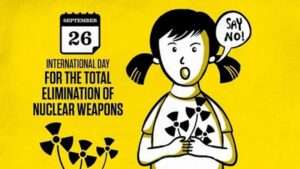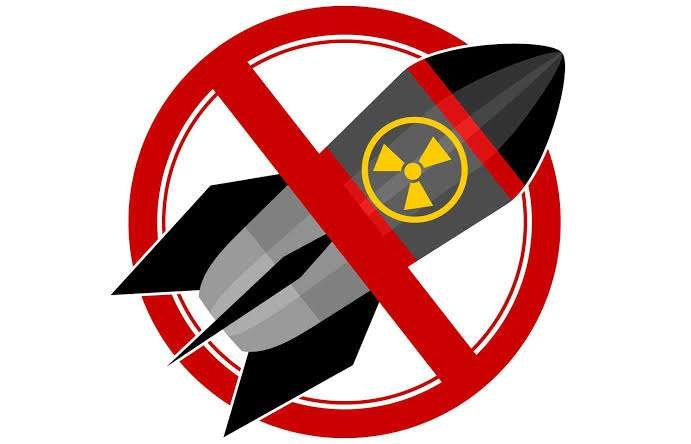International Day for the Total Elimination of Nuclear Weapons – September 26, 2022, history significance why we celebrate
International Day for the Total Elimination of Nuclear Bombs is observed on September 26 each year. One of the oldest goals of the United Nations is achieving global nuclear disarmament. The truth is that today, around 13,080 nuclear weapons remain. Something important is that countries possessing such weapons have well-funded, long-term plans to modernize their nuclear arsenals.
Countries where more than half of the world’s population live either have such weapons or are members of nuclear alliances. While any nuclear weapon has been physically destroyed according to a treaty, the number of deployed nuclear weapons has appreciably declined since the height of the Cold War.
HISTORY OF INTERNATIONAL DAY FOR THE TOTAL ELIMINATION OF NUCLEAR WEAPONS

In 1946, the General Assembly’s first resolution established that the Atomic Energy Commission has the mandate to make specific proposals for the control of nuclear energy and the elimination of not only atomic weapons but also all other major weapons adaptable to mass destruction.
The General Assembly endorsed the objective of general and complete disarmament in 1959. The first Special Session of the General Assembly Devoted to Disarmament, held in 1978, further recognized that nuclear disarmament should be the priority objective in the field of disarmament. This goal has been actively promoted by every United Nations Secretary-General.
The international arms-control framework contributed to international security since the Cold War. It also acted as a brake on the use of nuclear weapons. On July 7, 2017, the Treaty on the Prohibition of Nuclear Weapons was adopted.
This Treaty is so important since it is the first multilateral legally-binding instrument for nuclear disarmament to have been negotiated in 20 years. On August 2, 2019, the United States’ withdrawal spelled the end of the Intermediate-Range Nuclear Forces Treaty,
though the United States and the Russian Federation had previously committed to eliminating an entire class of nuclear missiles. September 26 is commemorated by the General Assembly as the International Day for the Total Elimination of Nuclear Weapons.
INTERNATIONAL DAY FOR THE TOTAL ELIMINATION OF NUCLEAR WEAPONS TIMELINE
1959
Nuclear Disarmament is Included
The General Assembly includes it as part of the most comprehensive goal of general and complete disarmament under international control (resolution 1378).
1978
The Special Session Devoted to Disarmament
It was affirmed by the Member States that their common ultimate objective is “general and complete disarmament.”
2010
State Parties Adopt A 64-point Action Plan
This action plan is adopted across all three pillars of the Treaty — nuclear disarmament, nuclear non-proliferation, and the peaceful uses of nuclear energy.
2017
The Prohibition of Nuclear Weapons Occurs
The treaty is adopted on July 7 and it is the first multilateral Treaty that is legally binding.
RECOMMEND STORIES
- IRCTC’s New Rule: Soon You Can Change Your Travel Date Without Paying a Cancellation Fee
- Dude Movie Review: Pradeep Ranganathan’s Youthful Rom-Com Balances Love, Humor, and cast
- SpaceX Launches 28 Starlink Satellites on Record-Tying 130th Falcon 9 Flight of 2025, Boosting Global Internet Coverage
- 24 Transgender People in Indore Attempt Suicide Seeking Justice, Police Launch Probe and Promise Swift Action
- Cough Syrup 22 Deaths: ED Raids Sresan Pharma Chennai Over Money Laundering Probe
HOW TO OBSERVE INTERNATIONAL DAY FOR THE TOTAL ELIMINATION OF NUCLEAR WEAPONS
It is a day to raise awareness
International days, such as the International Day for the Total Elimination of Nuclear Weapons, are occasions to educate the public on issues of concern. Nuclear weapons caused extreme destruction during WWII.
It is an opportunity to mobilize political will
This day can also be an opportunity to address global problems. Although nuclear weapons are under control, many global problems should be addressed by the international community.
It is a day to celebrate and reinforce humanity’s achievements
Even though international days existed before the establishment of the United Nations, the U.N. has embraced them as a powerful advocacy tool. The U.N. agenda is key to addressing the problems of humanity.
5 FACTS THAT YOU PROBABLY DO NOT KNOW ABOUT NUCLEAR WEAPONS
One weapon can destroy an entire city
As known, nuclear weapons destroyed entire cities and also killed most of their people.
They have severe consequences
Nuclear weapons also produce ionizing radiation, which has long-term health consequences, such as cancer and genetic damage, kills or sickens those exposed, and contaminates the environment.
Uninhabitable areas
The detonation of only one nuclear weapon in a modern city would strain existing disaster relief resources to the breaking point.
Spending on nuclear weapons deviate resources
Spending on nuclear weapons is not beneficial for society as detracts limited resources away from vital social services.
Consequences are very difficult to address
No state or international body could address the immediate humanitarian emergency nor the long-term consequences, appropriately, of a nuclear weapon detonation.
WHY INTERNATIONAL DAY FOR THE TOTAL ELIMINATION OF NUCLEAR WEAPONS IS IMPORTANT
This day is an occasion to reaffirm commitment
International Day for the Total Elimination of Nuclear Weapons provides an occasion for the international community to reaffirm nuclear disarmament commitment. The international community should address this problem as a priority.
It is an opportunity to educate people
This celebration is a special opportunity to educate people and also leaders. It is a good day to highlight the benefits of eliminating nuclear weapons.
This day also commemorates the importance of the United Nations
The United Nations is extremely important when it comes to addressing one of humanity’s greatest challenges. The U.N. has the experience and universal recognition.
Sandeep Raiza — Content Writer, Website Designer, SEO Strategist, and WordPress Expert AI specialist delivering impactful digital solutions that drive business growth.Combining creative storytelling with technical expertise.









